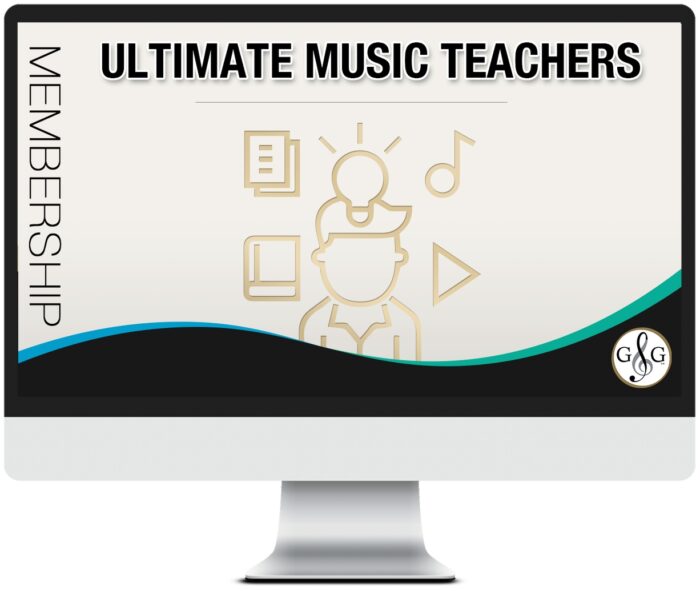How to Teach Music Theory Beginner A Lesson 10
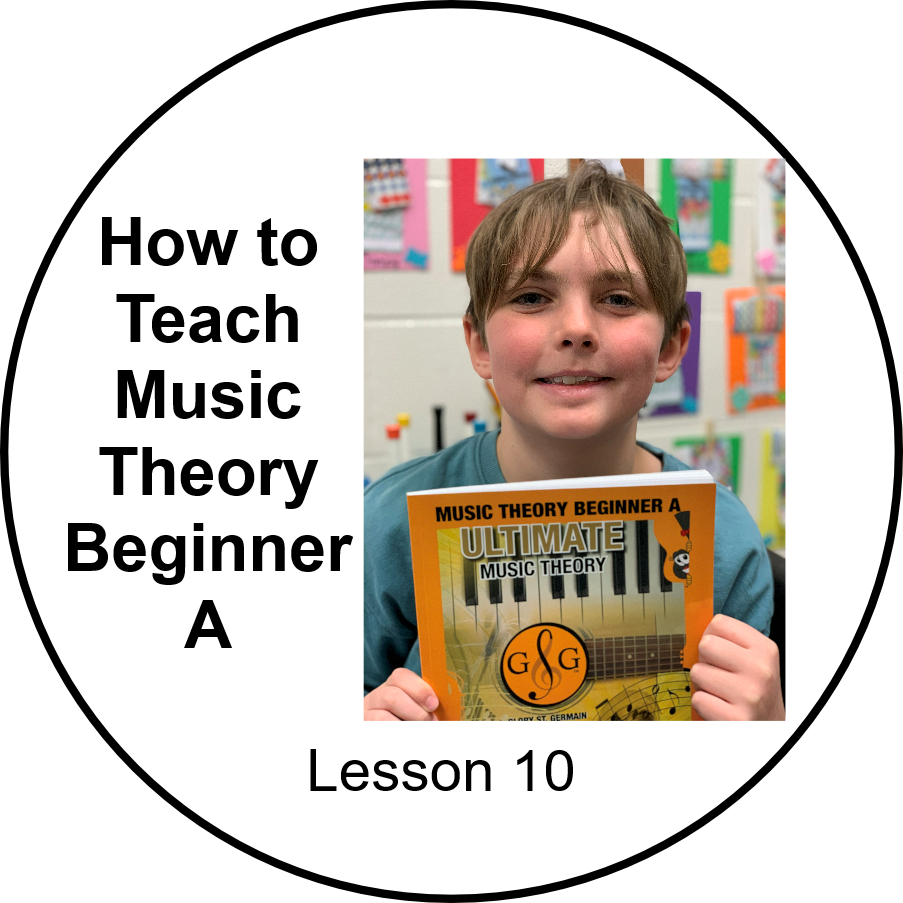
Welcome to the How to Teach Ultimate Music Theory Beginner A Workbook Series - Lesson 10 - Bass Clef.
The Ultimate Music Theory Beginner A, B and C Workbook Series is the perfect theory supplement for Beginner Students (ALL ages, ANY instrument). The UMT Beginner A, B, C Series works with every Method Series and with every Learning Style.
In this Blog, we will look at how to teach the concepts in the Music Theory Beginner A Workbook Lesson 10. Remember to read the first 10 Blogs in this series:
Music Theory Beginner A Overview
Music Theory Beginner A - Lesson 1
Music Theory Beginner A - Lesson 2
Music Theory Beginner A - Lesson 3
Music Theory Beginner A - Lesson 4
Music Theory Beginner A - Lesson 5
Music Theory Beginner A - Lesson 6
Music Theory Beginner A - Lesson 7
Music Theory Beginner A - Lesson 8
Music Theory Beginner A - Lesson 9
Join me as we explore tips and tricks to incorporate theory, ear training, sight reading, and games into every lesson. Let's jump in!
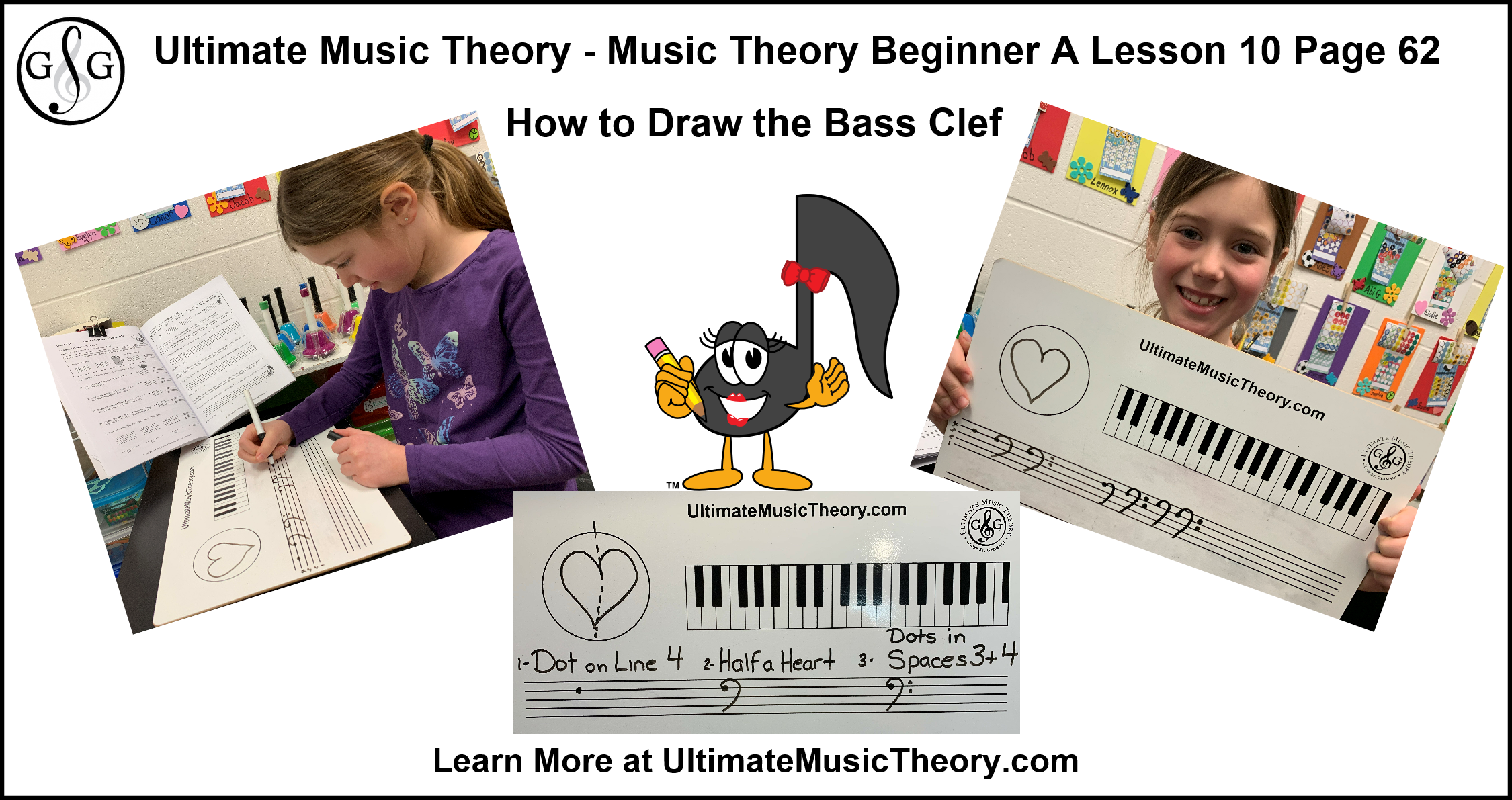
How to Teach Music Theory Beginner A Lesson 10 Pages 62 & 63 - Bass Clef
Lesson 10 starts off by teaching how to properly write the Bass Clef. I teach this first by reviewing how we say "Bass". The Bass Clef is not pronounced like a "bass" - a fish. The Bass Clef is pronounced like the "base" in "baseball". I tell my students it is pronounced like "base" in "baseball" as we are pitching the F below Middle C.
I encourage you to read my Blog "Learn How to Draw a Bass Clef" for more insight as to the importance of writing the Bass Clef (Bass Staff) Sign properly.
From my youngest students (age 4) to my oldest students, this is by far the easiest way to learn how to write a proper Bass Clef Sign. I do prefer to have my students complete Pages 62 & 63 at the lesson (after we have practiced writing several Bass Clef signs on our Whiteboard or staff paper).
On the UMT Website, under "Free Resources", we also have Bass Staff Theory Worksheets that are easy to download and print. These are in 2 sizes - Large and Small - so that they can be used by younger and older students. Check them out!
Free Resources Bass Staff Worksheets You can download the large or small Bass Staff worksheets.
You can also get your Ultimate Music Theory Whiteboard to easily teach how to draw the Treble Clef and much more.
How to Teach Music Theory Beginner A Lesson 10 - Bass Clef Middle C
Middle C is one of the easiest Landmark Notes for Students to learn. When we teach Middle C, I like to review what a "Landmark" is.
A "Landmark" is something that is easily seen/recognized to establish a specific location. If I was visiting Paris, I could use the Eiffel Tower as a Landmark. If I was in Sydney, Australia, I could use the Sydney Opera House as a Landmark. (What would be a good Landmark where you live?)
I tell my Student that, when I am in the Bass Staff, I can use Middle C as a Landmark. Middle C lives on a little line called a Ledger Line, and it is written above the Bass Staff.
You will notice that we are not expecting Students to write the Ledger Line for Middle C. On Pages 64 & 65, Students trace the Ledger Line for Middle C. We want them to get used to the proper placement of the Ledger Line for Middle C.
Before my Students start Page 66, I like to do a "Pop Quiz" using my Whiteboard or Staff Paper. I will draw 4 different examples of Middle C, and ask my Students to identify the correct placement. I also ask them to give me their reason as to why each of the other 3 placements are incorrect.
Here is an example of what my Pop Quiz looks like:
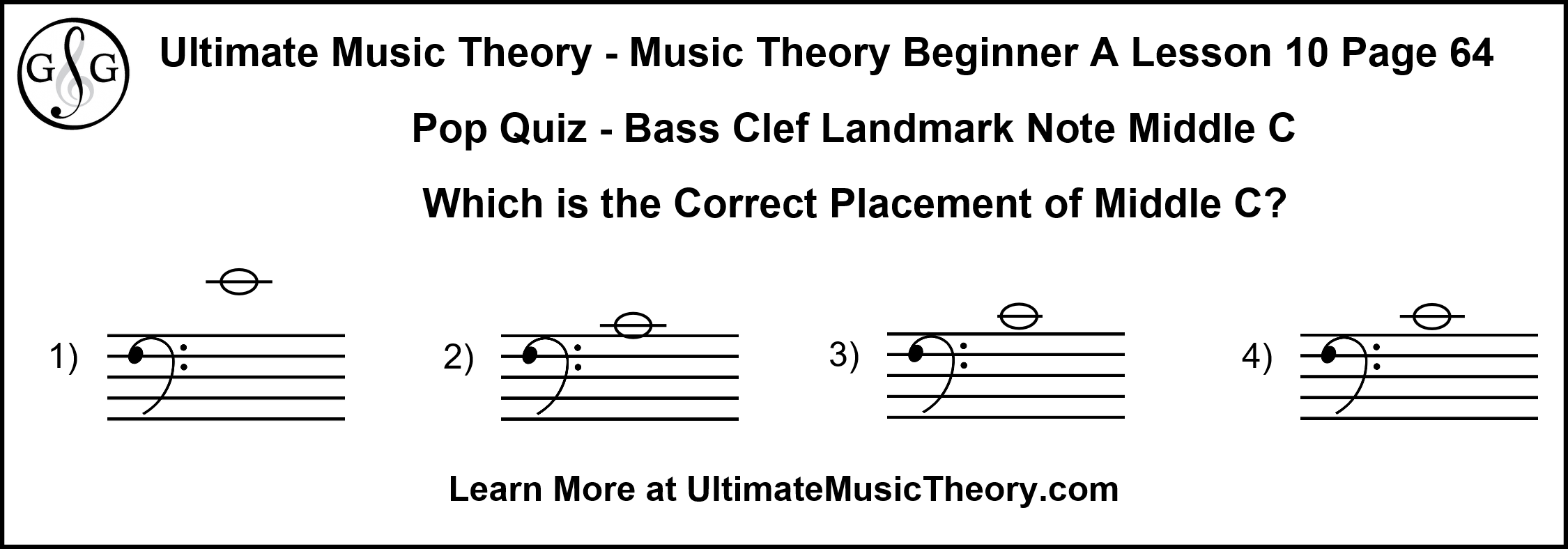
Pop Quiz Answer
1) Incorrect. Reason - the Ledger Line is written too far away from the Staff.
2) Incorrect. Reason - the Ledger Line is written too close to the Staff.
3) Incorrect. The Ledger Line is too short.
4) Correct. The Ledger Line is long enough that you can see the note in the middle of the Ledger Line. The Ledger Line is also spaced equally like the Staff Lines.
How to Teach Music Theory Beginner A Lesson 10 - Pre-Teaching Middle C in the Grand Staff
Even though we have not introduced the Grand Staff, you can explain that Middle C is written BELOW the Treble Staff and ABOVE the Bass Staff. So, when the Treble Staff and Bass Staff are joined by a Brace to make the Grand Staff, Middle C is in the "middle" - the area in between the Treble and Bass!
It is easy to see which hand is going to play Middle C when you look to see which Staff it is closest to.
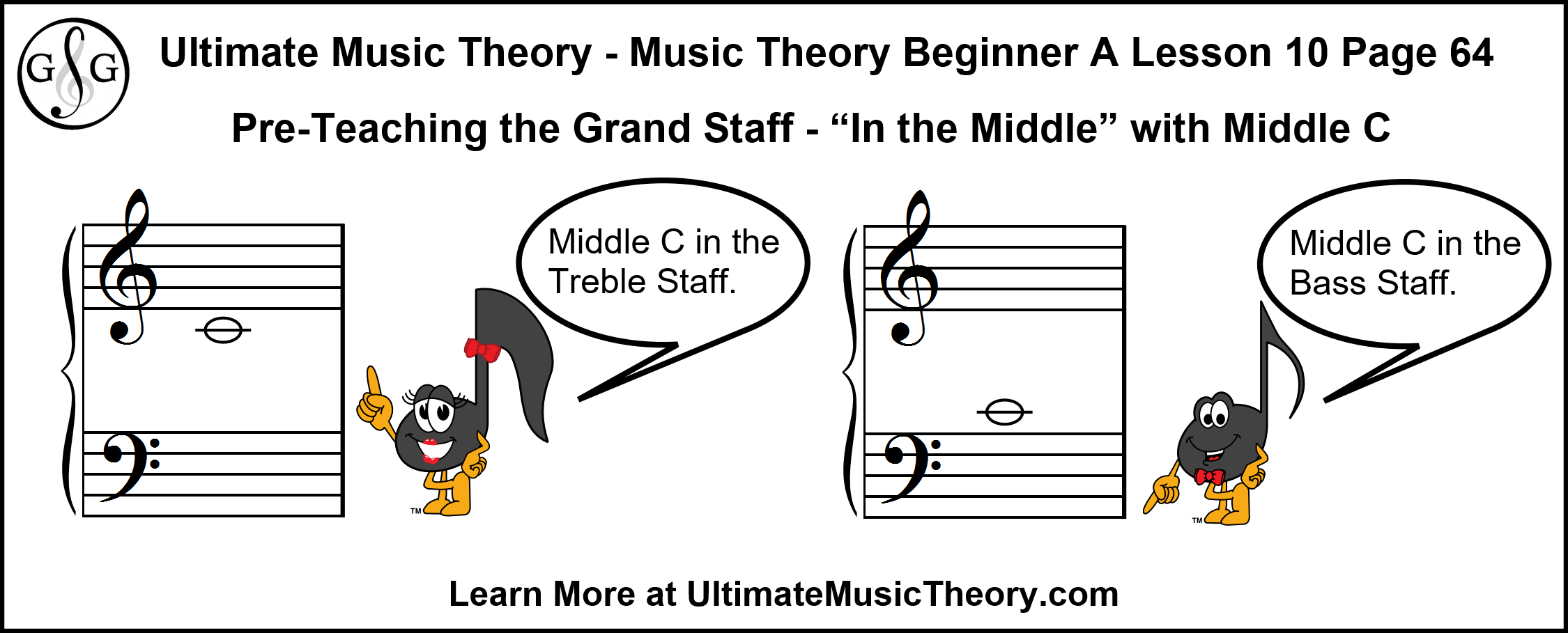
How to Teach Music Theory Beginner A Lesson 10 Pages 64 & 65 - Read it. Write it. Tap it. Play it.
There is a great benefit for Students to tap an exercise on the table (or piano lid) before they play it on the piano. By tapping it on the table, they can practice what it feels like before they play it on the piano.
The LEAP from Middle C to Bass F has a different feel than the STEP from Middle C to B.
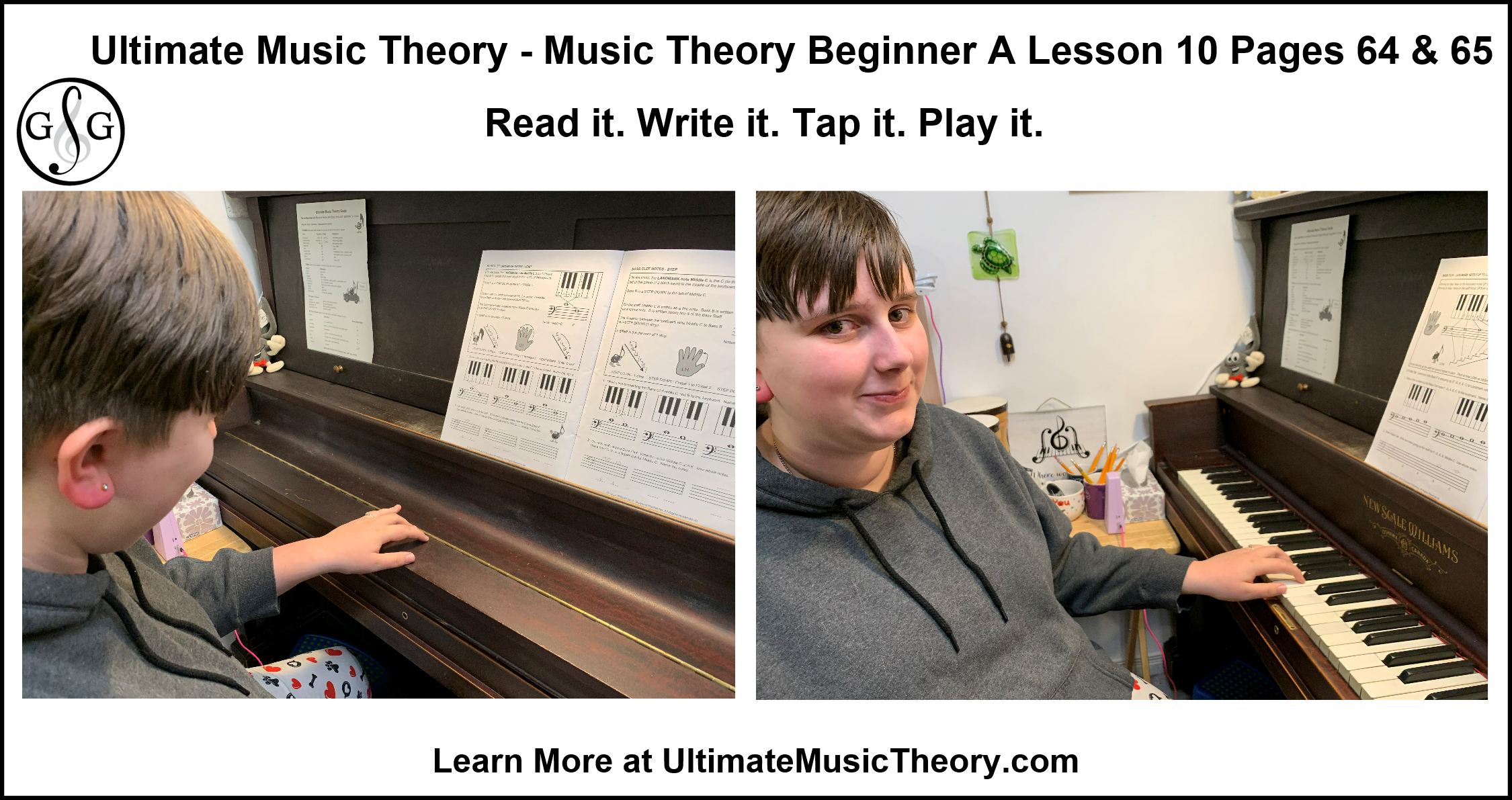
How to Teach Music Theory Beginner A Lesson 10 Pages 66 & 67
When you read the Example Box on Page 66 with your Student, it is pretty easy to see each line as it connects the notes on the ascending steps to the ascending notes on the Staff to the ascending pattern from F to Middle C on the Keyboard.
However, when you read the Example Box on Page 67, the descending patterns can be tricky as those descending lines cross over each other.
To help when a Student struggles, I have them select 5 different crayon colours. Then we use a different crayon colour to connect each letter name from the Steps to the Staff to the Keyboard.
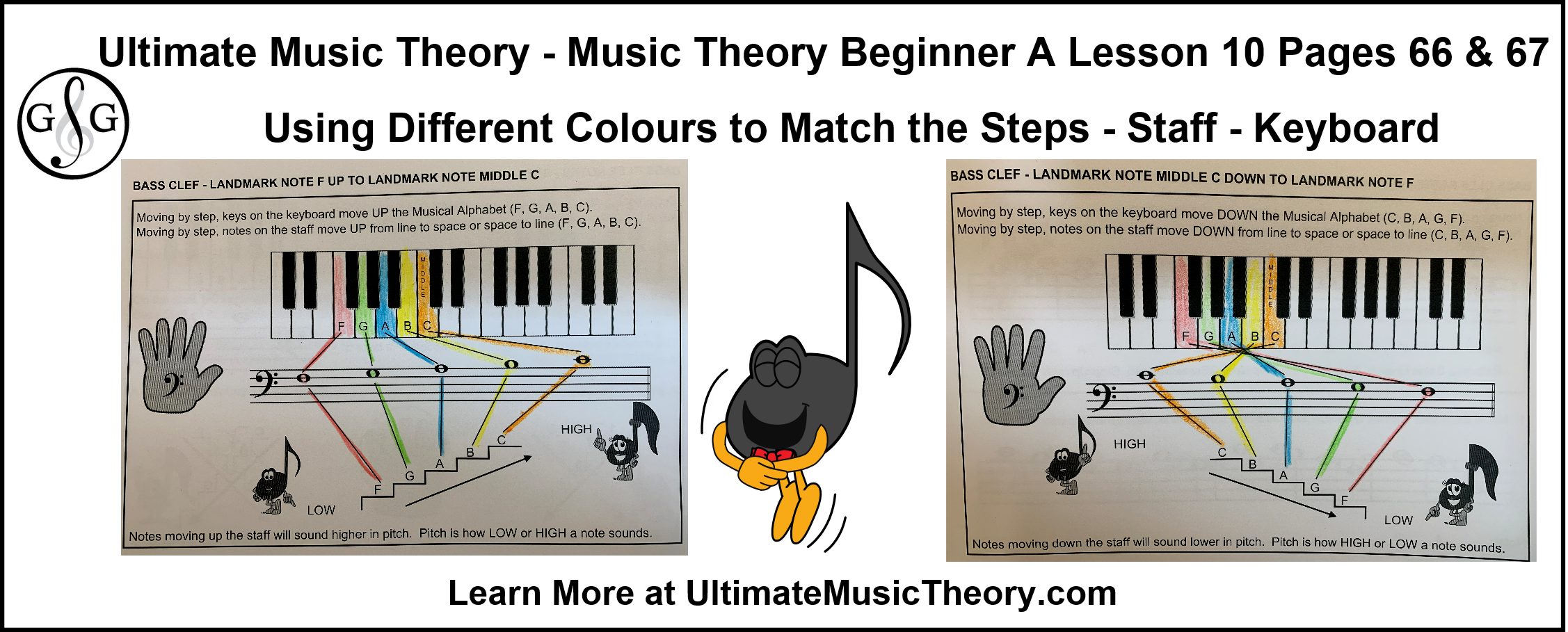
How to Teach Music Theory Beginner A Lesson 10 Pages 68 & 69
When I assign these 2 pages, I like to have my Students read and play the Example Box at the top of each page at the lesson.
Then, on our Ultimate Music Theory Whiteboard or on a piece of Staff Paper, we practice writing Middle C. Using a ruler can help a Student get that Middle C Ledger Line written correctly. We don't need to measure to the exact millimeter (or 100th of an inch), but it does need to look like it is the same distance as each of the Staff Lines.
I assign these 2 pages for homework. When I mark their homework, instead of circling an incorrect note, I ask the Student to play the exercise to see if they can find the Boo-Boo. When a Student can identify their error themselves by PLAYING what they wrote, they are learning the importance of "double checking" their work.
I absolutely love God's Timing. I was writing this Blog, and just after I wrote the above paragraph, I had to stop to teach. Nova came for her lesson and had actually completed this very page, but had made a couple of "boo-boos". So, we did our 3-Steps to have a Student Find and Fix Their "Boo-Boos" and voila - she found her mistakes and was able to fix them herself! (PS - she wanted me to tell you that her hair is wet and messy because she had just come from swimming in her pool!)
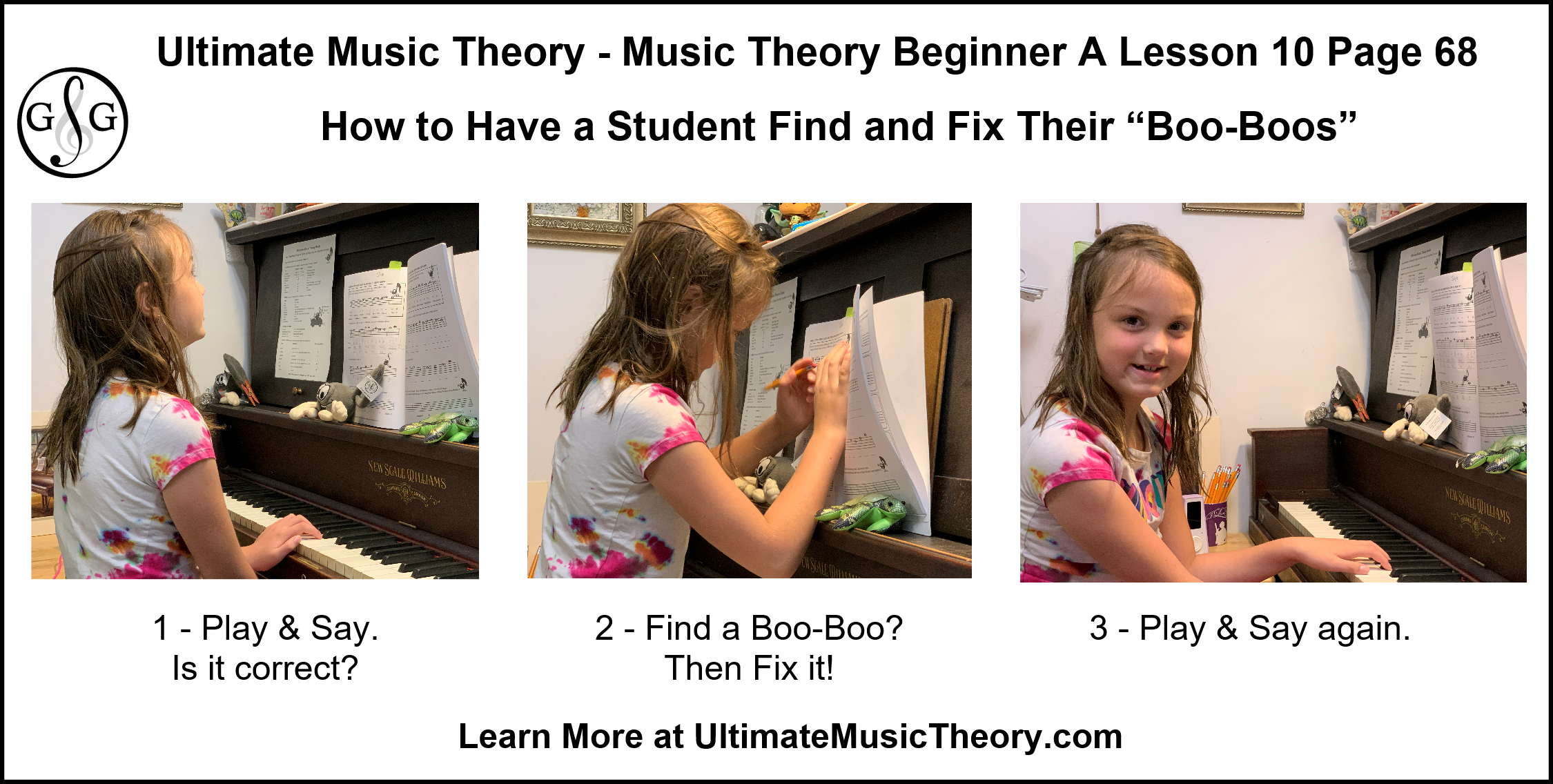
How to Teach Music Theory Beginner A Lesson 10 Page 70
Page 70 is another page that I prefer to have my Student complete as homework. In Question #1, I have found that some students will identify the first C, B, A, G, F correctly, but then they will incorrectly pitch the final A and C. So, their answer would look like this:
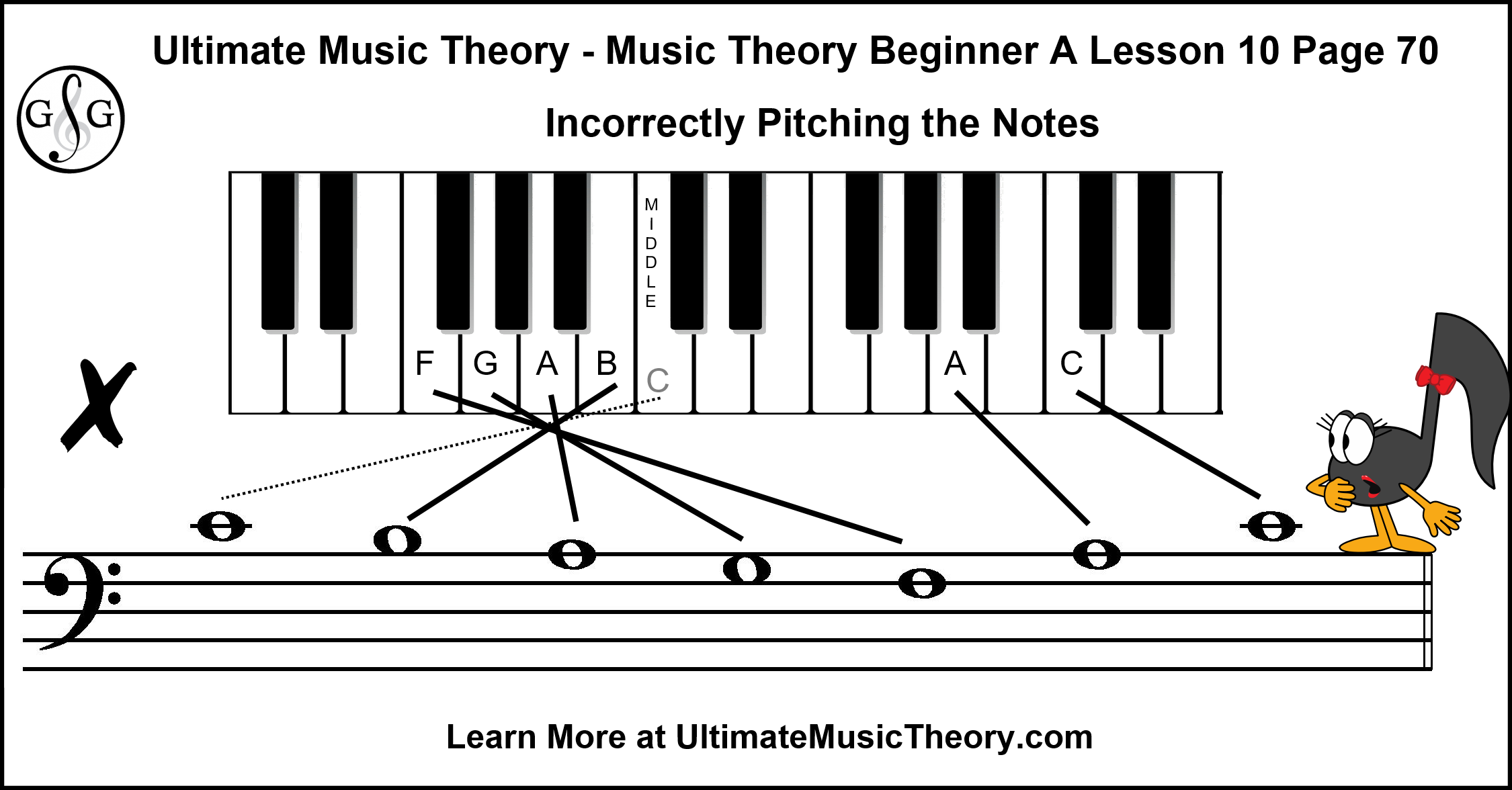
If your Student struggles with incorrectly pitching these notes, a good way to help them see that these are not different pitches is to use your ruler and draw a coloured line from the Middle C (note #1) to the Middle C (note #7). In my example below, I drew a blue line to show that it is the same Middle C (the line is straight across). Then I used a blue line to match each Middle C on the Staff to the same Middle C on the Keyboard.
Then I used a red line to show that the A (note #3) and the A (note #6) are on the same line. If they are on the same line, then they must be played on the same key on the Keyboard!
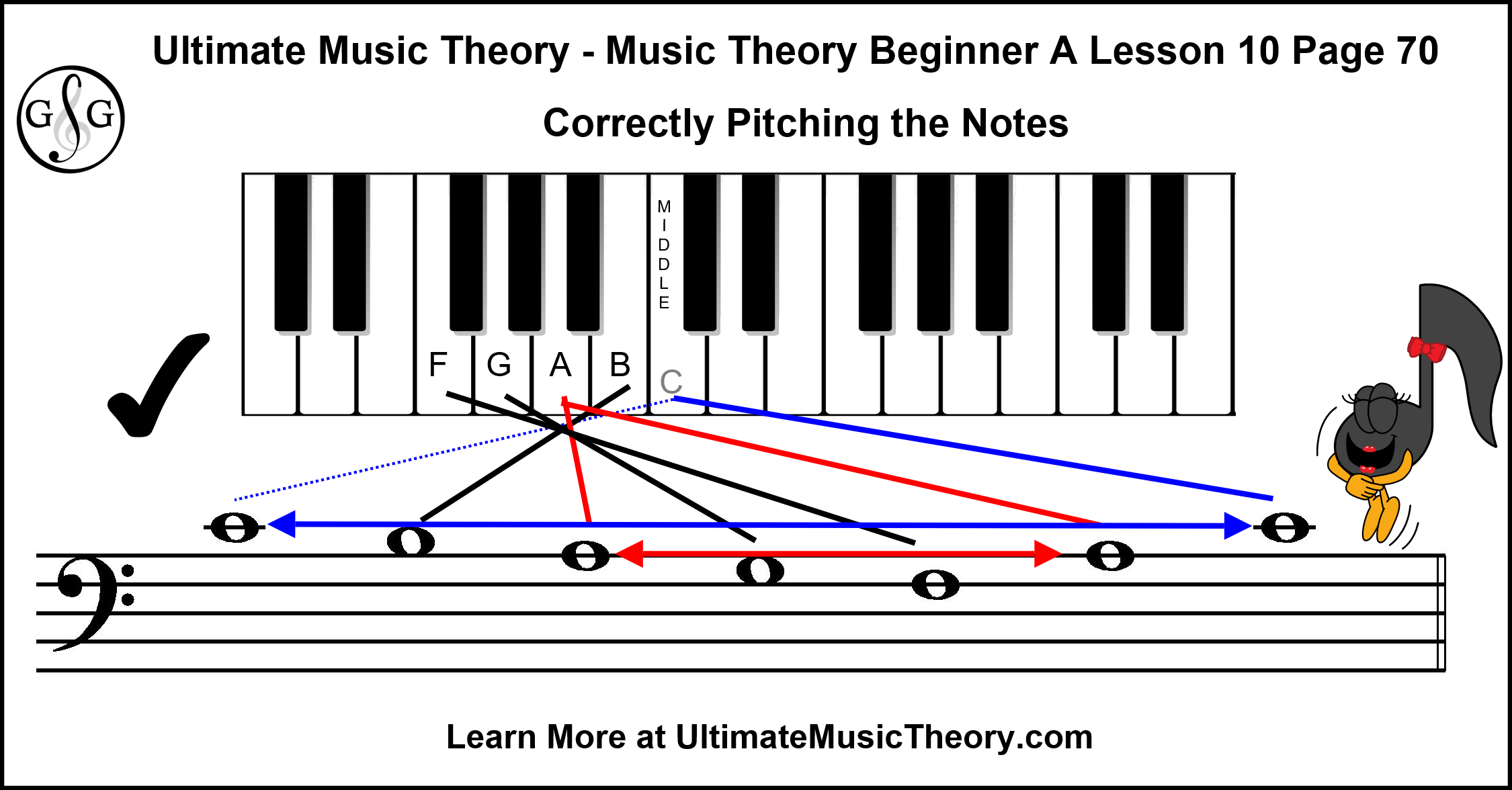
How to Teach Music Theory Beginner A Lesson 10 Page 71
When you do the Lesson 10 Review on Page 71, I recommend doing the same format as we did on the Lesson 9 Review on Page 61.
I have a lot of success (and student smiles) when I follow these steps:
- With the student looking at the piano/workbook, point to the 2 patterns in the question. Have the student identify what is the same and what is different between each possible answer.
- Play and sing along with the pattern. For example - for "a", play F - A and sing "Skip Up". Play it again and have the Student join you in singing "Skip Up". Then play A - F, sing "Skip Down, and then have the Student join you in singing "Skip Down".
- The student then covers their eyes or looks away from the piano. Play one of the 2 examples and ask the Student to identify which one you played.
- Before you "lock in their final answer", play the answer again and have the Student sing their answer (Skip Up or Skip Down) as you play it. Does it sound right?
- If the Student has identified the pattern as "Skip Up", but I played the "Skip Down", instead of saying "wrong", I like to say "Let's listen and sing this again". Then we review the sound emphasizing with our body the direction that the Student has selected. Is our body moving in the same direction as the sound? By helping them to see/hear why their answer is incorrect, you are teaching them to explore "why" (instead of just picking the other answer because their first choice was wrong).
Remember, you do not have to be a Pitch-Perfect Singer! You just need to have fun!
For Question 2 on Page 71, we are seeing the Bass Staff and the Treble Staff for the first time side-by-side. I like to remind them that the Treble Clef can turn into a "T" (and it is Tall), while the Bass Clef can turn into a "b" (and it is for the notes at the bottom of the Keyboard).
Bonus Tip - With a Grand Staff, the Treble is on the Top (both start with a "T") and the Bass is on the Bottom (both start with a "B").
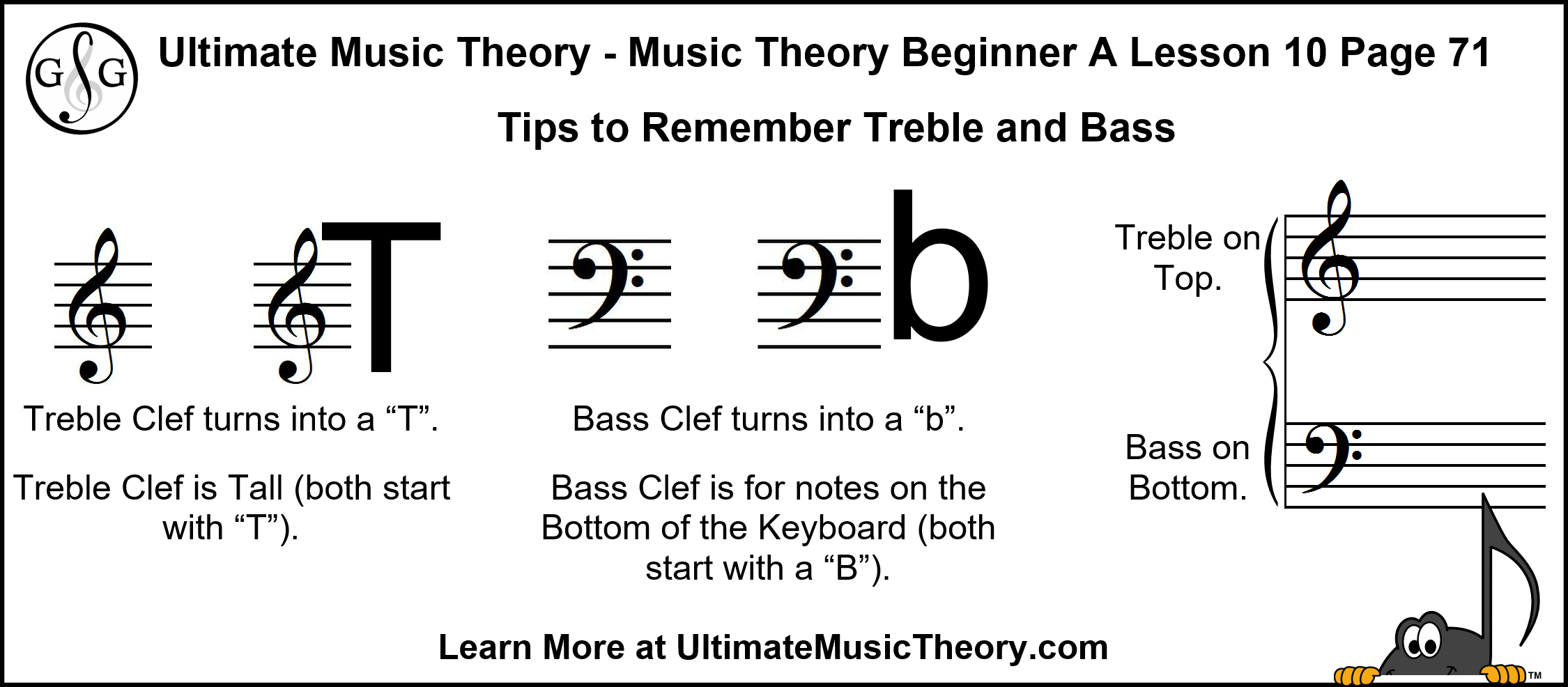
If you have any Tips or Tricks to help Students remember the Treble Clef and the Bass Clef, please post them in the Comment Section at the bottom of this blog.
With a Smile and a Song,
Shelagh McKibbon-U'Ren
The Ultimate Music Theory Workbook Series - Beginner A, B, C, Prep 1, Prep 2, Basic, Intermediate, Advanced and Complete all-in-one Rudiments!

The UMT Workbooks include 12 Lessons & Review Tests, Music Theory Guide & Chart and 80 Flashcards in each workbook.
- 12 COMPREHENSIVE LESSONS - Simplify complex concepts
- GUIDE and CHART - Memory Joggers for fast and easy reference
- 12 REVIEW TESTS - Accumulative study including final exam
Ultimate Music Theory helps students prepare for nationally recognized theory exams, including the Royal Conservatory of Music Exams.
A Proven Step-by-Step Workbook System!
- LEARN FASTER – Use on any device, phone, tablet, computer
- EXPLORE – Identify written & audio notation
- PLAY – Sight Reading and Ear Training Games and much More!
Students will LOVE the UMT Flashcard System (App powered by Brainscape) that correlates to each lesson in the Beginner A, B, C, Prep 1, Prep 2, Basic, Intermediate & Advanced Workbooks.
Have fun building a foundation in Music Theory, Ear Training, and Sight Reading.
The One and ONLY Music Theory App & Matching Workbook!
Get Access To UMT Worksheets, Games, Activities, Posters, Certificates, Courses, Coaching Calls, Community & More!
Ultimate Music Teachers Membership
♪ LEARN ♪ PLAN ♪ TEACH ♪ GROW
The One & ONLY Ultimate Music Teachers Membership
To Become A UMT PRO!
Your Success Path Starts Here - Go To TeachUMT.com Today!
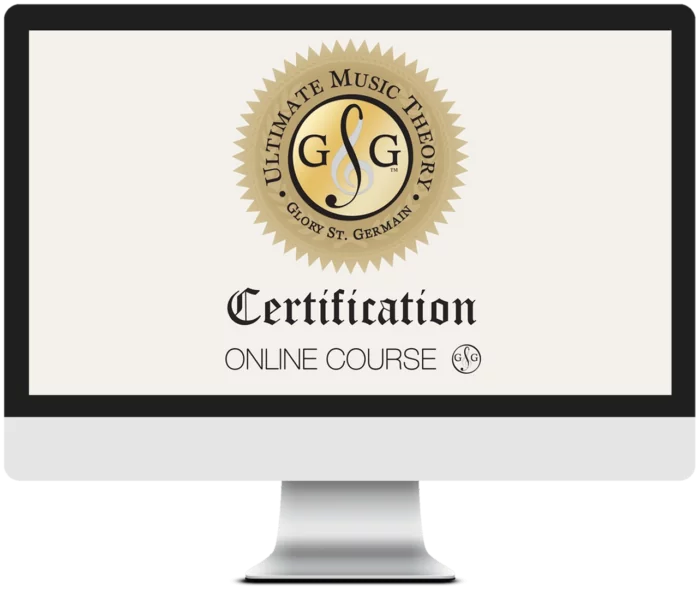
Ultimate Music Theory Certification Elite Educator Program - Online Teacher Training to Elevate Your Income, Impact Your Teaching and Grow Your Expert Music Teaching Business. Get Certified!
Click HERE to discover what you will learn in the Ultimate Music Theory Certification Course. Your professional development Online Teacher Training starts here!
Keep on Learning... With a Smile and a Song!
Shelagh McKibbon-U'Ren

